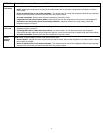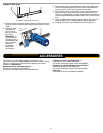
7
Temperature
is too warm
■ New installation - Following installation, allow 24 hours for the refrigerator and freezer to cool completely.
NOTE: Adjusting the temperature control(s) to the coldest setting will not cool either compartment (refrigerator or freezer)
more quickly.
■ Doors are opened often or not closed completely - This allows warm air to enter the refrigerator. Minimize door openings,
keep the doors fully closed, and make sure both doors are properly sealed.
■ Air vents are blocked - Remove items that are immediately in front of the vents.
■ Large amount of warm food recently added - Allow several hours for the refrigerator to return to its normal temperature.
■ Controls are not set correctly for the surrounding conditions - Adjust the controls to a colder setting. Check the
temperature again in 24 hours.
Temperature
is too cold
■ Controls are not set correctly for the surrounding conditions - Adjust the controls to a warmer setting. Check the
temperature again in 24 hours.
■ Top refrigerator shelf is colder than lower shelves - On some models, air from the freezer enters the refrigerator
compartment through vents near the top refrigerator shelf. As a result, the top shelf can be slightly colder than lower shelves.
■ Air vents are blocked - Remove items that are immediately in front of the vents.
Interior
moisture
buildup
NOTE: Some moisture buildup is normal. Clean with a soft dry cloth.
■ Room is humid - A humid environment contributes to moisture buildup. Only use the refrigerator in an indoor location, with as
little humidity as possible.
■ Doors are opened often or not closed completely - This allows humid air to enter the refrigerator. Minimize door openings,
keep the doors fully closed, and make sure both doors are properly sealed.
PROBLEM Possible Causes and/or Recommended Solutions


















